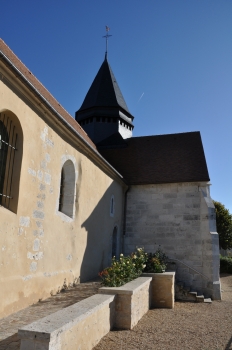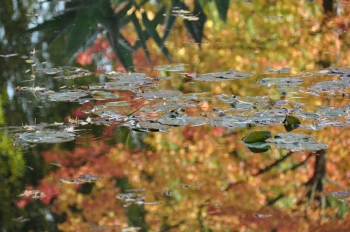February 23, 2012
This is what is needed at Giverny to keep Monet’s pond as clean as a mirror:
– a flat boat copied from Monet’s, very common in his times,
– a big garbage can,
– a carp net,
– thick gloves to protect your hands.
Equipped with these very simple tools, the gardener is ready for the constant battle he has to fight.
The battle field is the surface, and the invaders are of different kinds. The main body of the army is made out of dried leaves and seeds. Drown bugs must go, too.
Alone against the ennemy that is continuously renewed, the gardener must be a super heroe. He needs a good balance, a strong back and strong arms to fish the dirt and take it out, leaf after leaf. Good spirits are essential too. Patience and perseverance.
No wonder the algaes and leaves fishing gardener is the star of the pond, photographed millions of times by the visitors of Giverny.
Posted in Water-Garden No Comments »
February 8, 2012
It is hard to imagine that in seven weeks, the gardens will be full of flowers again. For the moment, it is icy and snowy at Giverny.
Yesterday morning, I visited the closed and cold Monet garden. It was probably the most beautiful day of the winter. A few inches of snow covered pond and park, and shined in the sunlight. It looked so still and sleepy… But life is not far away, just hiding in every little hole.
Under the Japanese bridge, a bird has stamped its very regular footsteps, designing new curves to add to those imagined by Claude Monet.
Posted in Giverny, Water-Garden 1 Comment »
January 23, 2012
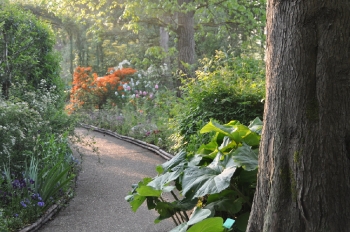 A quiet path, early in the morning in Claude Monet’s water garden at Giverny.
A quiet path, early in the morning in Claude Monet’s water garden at Giverny.
The big tree on the right is the trunk of a taxodium, a deciduous coniferous that loves river sides. The big leaves at its feet are petasites, also known as butterbur, a plant that grows wild along the streams in the surroundings of Giverny.
An orange azalea tops a bed of pink tulips and pink forget-me-nots.
This picture was taken last Spring, the 4th of May.
Posted in Water-Garden 2 Comments »
January 15, 2012
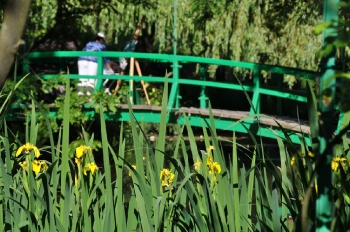 It is many painters’ dream to be able to stay in Monet’s garden to paint.
It is many painters’ dream to be able to stay in Monet’s garden to paint.
If your medium is watercolor, pencils, ink… no problem. Just sit down on a bench (preferably) and paint. But if you use acrylic, for instance, and need an easel therefore, you must ask for allowance. Please get in touch with Fondation Monet. If there aren’t too many requests for the day you wish, you will be granted the privilege of staying in the gardens after closing time. This is the best way to feel just like Monet, almost alone on the grounds. Same vibrations, same inspiration. Have a great time!
Posted in Monet's flower garden, Water-Garden 8 Comments »
December 2, 2011
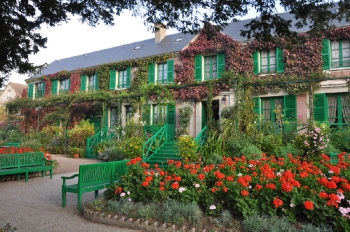 Flashing reds and greens in the soft light of October, this is what Monet’s garden offers in October in the area in front of the painter’s house.
Flashing reds and greens in the soft light of October, this is what Monet’s garden offers in October in the area in front of the painter’s house.
The “Monet green” spreads on benches, shutters, stairs… creating a strong contrast with the formal geranium beds and the virginia creeper on the façade.
Posted in Monet's House No Comments »
November 25, 2011
 In front of his second studio, a pink house he built in 1899 on the corner of his estate, Monet designed a colorful area of parallel flower beds.
In front of his second studio, a pink house he built in 1899 on the corner of his estate, Monet designed a colorful area of parallel flower beds.
In October, the tall flowers of late season mix their pinks, blues, yellows, oranges and reds and their different textures ans shapes, creating a living painting that moves in the breeze.
Sages, dahlias, asters, cosmos, roses, black eyed Susan, tithonias are all enchanting September and October.
Posted in Monet's flower garden No Comments »
October 11, 2011
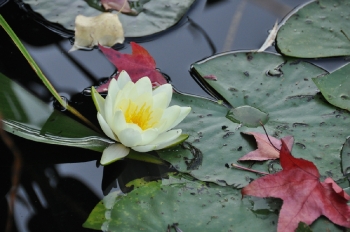 Autumn leaves fall on Claude Monet’s pond at Giverny, creating new beauties, new color harmonies.
Autumn leaves fall on Claude Monet’s pond at Giverny, creating new beauties, new color harmonies.
Posted in Water-Garden 1 Comment »
September 27, 2011
The beauty of September in Monet’s garden at Giverny lies in the bright colors displayed by giant flowers.
Pink or red huge dahlias, tall yellow helianthus, enormous purple asters, supersized yellow or brown sunflowers have now reached their final height.
In the main alley, nasturtiums flow like a river on the sloping ground, pretending to fill the pond of the water garden.
Their petals shimmer in the sunshine, just like paint on an impressionist canvas.
Posted in Monet's flower garden No Comments »
August 20, 2011
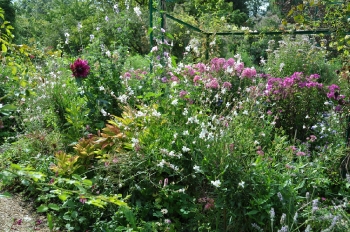 Summer is a gorgeous time in the gardens, especially at Giverny. While water lilies are at their best, the flower garden offers an explosion of colors.
Summer is a gorgeous time in the gardens, especially at Giverny. While water lilies are at their best, the flower garden offers an explosion of colors.
Dahlias in every shapes and shades show their heads among the light butterfly like gauras, phlox and lavenders spread their scents, gladiolis bent graciously over the alleys, surrounded by sages and verbenas. The list of blooming flowers is endless.
Instead of carpeting the ground like in spring, summer flowers stand, tall, imposing and delicate at the same time, offering another experience of the garden.
Posted in Monet's flower garden 3 Comments »
April 15, 2011
In the 19th Century, trees used to be white in Spring. There were white blossoms of cherry trees, white plum trees, white pear trees… Apple trees were slightly tinted with pink when budding, but became white when in bloom. Only southern trees like peach or apricot trees could be pink, however they were rarely to be seen in Normandy.
So we can imagine the novelty of introducing exotic varieties like crab apples, Japanese cherry or plum trees in a little village on the countryside like Giverny. Their pink blossom must have looked unique to Monet, and to his neighbours.
The pink exotic trees are widely spread by now, but in April their short beauty still enchants Spring in Claude Monet’s gardens.
Posted in Monet's flower garden 3 Comments »
March 6, 2011
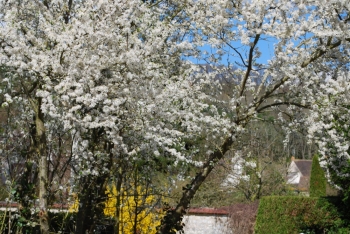 What is your idea of Giverny? A lady told me that before coming, she imagined Monet’s place isolated in the countryside, standing on its own like a chateau. She was surprised to discover it was part of a village.
What is your idea of Giverny? A lady told me that before coming, she imagined Monet’s place isolated in the countryside, standing on its own like a chateau. She was surprised to discover it was part of a village.
But this is no wonder, as Monet chose an existing house for his home. In the Seine valley, farms are not scattered around in the fields, but form villages of a few hundreds inhabitants. The rural dwelling is accompanied by a garden, where the peasant grows his vegetable and fruit.
This is exactly what fascinated Monet. When he discovered Giverny in April 1883, the fruit trees where in blossom, offering lovely views that attracted his painter’s eye.
Giverny hasn’t changed a lot through the decades. The village’s administration pays attention that it keeps its countryside mood, as quiet as possible. Except for the two museums and a few restaurants, you won’t find many tourism oriented places.
This is part of the charm of Giverny, sort of a feeling that things are still the same. A stroll through the main street of the village will lead you to the newly renovated nice little church.
Posted in Giverny 1 Comment »
December 14, 2010
 Monet
Monet
Thanks to Google maps, centered on Monet’s bust at Giverny, this is how Monet’s gardens look from a bird’s view. (it may take a while to load)
The pattern of flower beds looks very straight.
The green roof on the left is the greenhouse.
The big dark roof along rue Claude Monet is Monet’s home.
On the right you can see the big roof windows of his third studio.
If you drag the picture to the left you will visit the village of Giverny. The Museum of Impressionism has terrace roofs.
If you drag the picture to the bottom you will see the poplar grove that was chopped down last year.
Have a nice virtual tour of Giverny!
Posted in Giverny 2 Comments »
December 12, 2010
It snowed for the second time of the season at Giverny last Wednesday, what is rather unusual so early, at the end of Autumn.
But the gardeners are still working in the garden! They plant the bulbs and pansies for next Spring. Thousands of them. And when the weather is really too cold and snowy, they stay inside and maintain the gardening tools.
Do you recognize on the picture the ladies corner, this round shaped little square under the paulownia, where Mrs Monet and her daughters used to sit down in the afternoon?
Posted in Giverny, Monet's flower garden No Comments »
December 10, 2010
The church of Giverny looks beautiful! The works are almost finished by now, they have lasted three years.
Everything was scanned, repaired or replaced, from the roaster on the top of the spire to the murals inside of the choir. The result is stunning.
The church of Giverny deserves this attention. The oldest part dates back to the 11th Century.
Claude Monet and his family celebrated their religious events in this sanctuary.
Monet is buried in the nearby cemetery.
Posted in Giverny 1 Comment »
November 29, 2010
The beauty of late season at Giverny relies on the reflections on Monet’s pond.
The surrounding trees turn red, orange, yellow and dip their image into the water.
Their warm colors split in dots of changing shapes form a stunning contrast with the cold blue and perfectly defined leaves of the remaining water lilies.
This picture was taken one month ago. Now the leaves have been blown away, and Fondation Claude Monet is closed until next 1st April.
Posted in Giverny, Water-Garden No Comments »
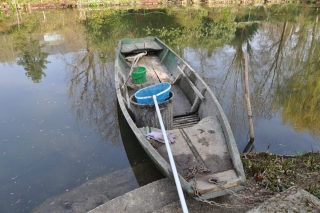
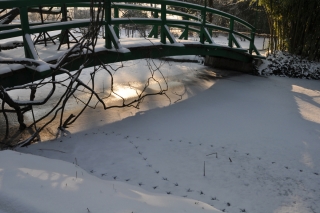





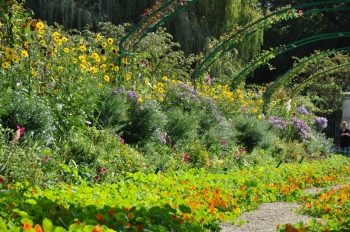

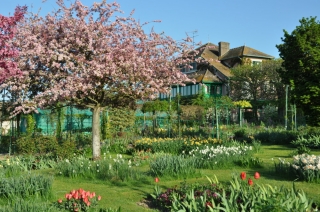

 Monet
Monet
